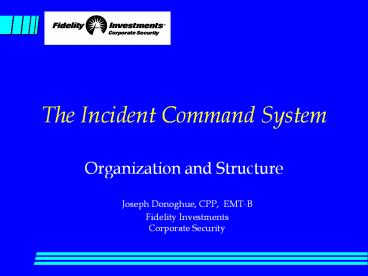The Incident Command System - PowerPoint PPT Presentation
1 / 25
Title:
The Incident Command System
Description:
The Incident Command System – PowerPoint PPT presentation
Number of Views:135
Avg rating:3.0/5.0
Title: The Incident Command System
1
The Incident Command System
- Organization and Structure
Joseph Donoghue, CPP, EMT-B Fidelity Investments
Corporate Security
2
Training Objectives
- Give students a high level overview of an 8
hour course of instruction - Introduce the ICS system, its organization,
structure, and recommendations for use - Show how security professionals can utilize the
system and benefit from its design - Highlight examples of ICS used by Security
3
Development of ICS
- Developed by the National Interagency Fire Center
- A steering group comprised of representatives
from the following was used to guide the
curriculum. - Search Rescue
- Law Enforcement
- Structural Fire
- Wildfire
- EMS
4
Developments in the 90s
- State Emergency Management Agencies are using the
system for public safety incident management
some states are mandating its use - Mandated use by SARA, OSHA, EPA for hazardous
materials incidents - NFPA, IACP endorse ICS as an All risk, all
agency system - Extensive training available at federal and state
levels, and through private vendors
5
Basic Principles
- Planning
- Organizing
- Communicating
- Evaluating
- Directing
- Coordinating
- Delegating
6
Uses for the ICS System
- Fires, evacuations, and multiple casualty
incidents - Planned events (company functions)
- Private sector emergency management programs (
your company ) - Major natural hazards disaster response
7
Incident Command System Organization
8
Incident Command System Organization
- There are 5 Management positions which comprise
the ICS foundation - In small incidents, the Incident Commander (IC)
may wear all hats - Larger incidents usually require the separation
into Sections and sub-divided as needed
9
Command
- Incident Commander (IC) has overall
responsibility at the incident or event - Sets objectives and priorities looks at the big
picture - IC is not a risk taker, but a risk evaluator!
- This is On Site management
10
Incident Commander
- Person in charge of the incident
- Stays in charge until relieved by competent
superior - May assign personnel for staff and support roles
- May have one or more deputies,who must be fully
qualified to assume incident command - In taking over incident, IC must have a full
briefing on activities to date and make a
notification that a change in command is taking
place
11
Operations
- Develops the tactical objectives and organization
- Conducts the tactical operations to carry out the
plan - Directs all resources
12
Planning
- Develops the action plan to accomplish the
objectives - Collects and evaluates information
- Maintains resource status
13
Logistics
- Provides resources and all other services needed
by the incident responders - Beans, Bullets and Band-Aids
14
Finance/Administration
- Monitors costs related to incident
- Provides
- accounting
- procurement
- time recording
- cost analyses
15
Developing the Organization
- ICS is built to be expandable, based on incident
size and scope it should be able to get larger
or smaller as the situation demands - Many incidents never require detailed levels of
structure, but once built in to a system, it is
easier to manage a growing incident - Most incidents will require only 2 layers of
structure - Command
- Single Resources
16
Unified Command
- All responding agencies will jointly develop a
common set of incident objectives and strategies,
without losing or giving up agency authority,
responsibility or accountability. - Incident will function under a single coordinated
Incident Action Plan - One Ops Section Chief will have responsibility
for implementing the plan - One Incident Command Post will be established
17
General Guidelines
- Establish an Incident Command Post (ICP)
- Designate the location and make it known to all
incident resources - Account for expansion if situation requires
- Can be a mobile or fixed facility
- Once established, try not to move it
- Manage the activity in the ICP!
18
General Guidelines
- Develop Initial Organization
- Fill essential top level staff functions first
unit level positions can be filled as required - Overestimate, rather than underestimate
- Basics needed first are
- Operations
- Resource Check-In
- Resource Tracking
- Logistical support
- Build it as you need it
19
General Guidelines
- Consider specialized needs
- Saves IC time when others can handle things like
media, agencies, etc. - Maintain good span of control
- Use 3-7 persons/supervisor as a guide
- Anticipate and plan for growth
- Demobilize elements when no longer necessary
20
Transfer of Incident Command
- May be during Shift Change
- May occur when a senior person elects to assume
the Incident Commander role - Takes place when operational periods change
(shifts) - Takes place when lower ranking but more qualified
person would be best because of unique
circumstances (site knowledge or specialized
skill) - Should be a face-to-face briefing for transfer of
information and situation
21
De-Escalation
- Document Everything! You are responsible for
what you do or fail to do in managing an incident
- Conduct After Action Reviews and Lessons Learned
sessions to gain knowledge and improve
performance - Provide crisis counseling or debriefing for
responders as needed offer it even for small
incidents - Rehab equipment and replace lost or used supplies
for next incident
22
Summary
- Use of ICS will help organize and add logical
flow to planned events and emergencies - Additional training modules are available for
more detail - ICS is a proven tool in the management and
coordination of known and unknown incidents
23
FSSI ICS OrganizationY2K response plan
24
Resources and References
- Federal Government Printing Office
- ICS National Training Curriculum, Module 1
I-100--dated 1994 (this is 1 in a series of
modules) - State EMA training coordinators
- NFPA 1600 and 1620
- http//www.fema.gov/EMI/is195lst.htm
25
Thank You All































